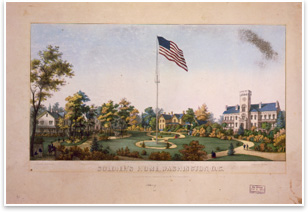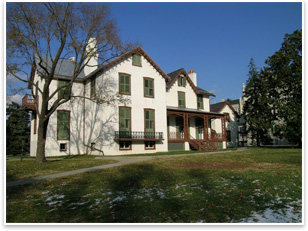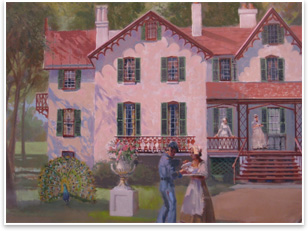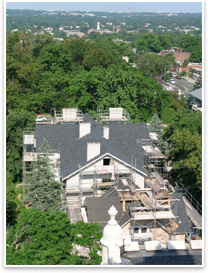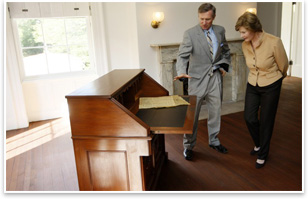
| A
Presidential Sanctuary: Restored Lincoln’s Cottage Tells Story
of the Emancipation Proclamation
“This is the only site in Washington that will tell the story of the Lincoln presidency,” adds Moe, of the cottage with its pebble-dash stucco façade and gabled roof. “It is the only site that represents his presidency outside of the White House, and all told, this place is probably the most important site of Lincoln’s presidency.” The Lincoln family resided here from June through November during the summers of 1862, 1863, and 1864, transporting 19 wagonloads of household furniture and goods up the Seventh Street turnpike to the cream-colored, 34-room cottage. Lincoln commuted daily on horseback to the White House and, along the way, talked with returning soldiers and nodded to poet Walt Whitman. In the cottage, he met with cabinet officials, delegations, and political adversaries. Here he paced the floor at night and grieved for his dead son and for the nation’s fallen soldiers. His refuge from the capital’s political pressures, heat, and clamor, its solace gave Lincoln the tranquility to shape his landmark Emancipation Proclamation, the 1863 presidential order abolishing slavery in the South. This is the compelling story the cottage will tell.
The Trust used 19th-century photographs to return the cottage to the Civil War era, including one from Lincoln’s family album. Construction crews are jackhammering up concrete sidewalks to install 19th-century walkways. “We want to get the 21st century off these grounds and move the 19th century onto the area,” says Frank Milligan, director of President Lincoln’s Cottage. “Our goal is to return these grounds to the place Lincoln enjoyed.” The project team includes preservation architect and lead designer Hillier Architecture of Philadelphia; construction management by the Christman Company of Alexandria, Va.; and exterior restoration by general contractors J.S. Cornell & Son and Historic Structures of Washington, D.C.
Conveying Lincoln’s philosophy In several rooms, visitors will hear historical voices and see projections of Lincoln’s friends, family, staff, contemporaries, and Whitman. This personal, novel experience will tell the story of Lincoln, his family life, and how he worked out the crucial decisions he made here. In the library, visitors can take copies of Lincoln’s books down off the shelves and see the passages he read aloud to his guests. Lincoln’s favorites included Shakespeare’s histories, especially Richard II and Henry IV, which mirrored his thoughts on equal opportunity for all in the face of tyranny.
Pondering the Emancipation Proclamation One of those policies was pondering when and how to abolish slavery while preserving the Union. “Lincoln felt that if he was going to be remembered for anything, it would be for this act, issuing the Emancipation Proclamation,” notes Erin Carlson Mast, curator of President Lincoln’s Cottage. Politicians, friends, and foes counseled Lincoln that issuing the controversial act and retaining the 13th Amendment abolishing slavery in the Republican Party’s 1864 presidential election platform could lose him re-election; but Lincoln would not be swayed. The 13th Amendment remained and he won the election by a landslide.
To Milligan, the purpose of the restoration—to bring Lincoln to life—is clear. “When people get into their cars to leave here, we don’t want them necessarily talking about the reproductions,” notes Milligan, “we want them to talk about the message of Lincoln.” |
||
Copyright 2007 The American Institute of Architects. All rights reserved. Home Page |
||
news headlines
practice
business
design
recent related
› Tudor Place: Democracy Starts at Home
The Lincoln Cottage is located on the campus of the Armed Forces Retirement Home in Washington, D.C. For more information, visit www.lincolncottage.org.
Photos
Images courtesy of the National Trust for Historic Preservation
1. A color lithograph of the Old Soldiers Home by Charles Magnus.
2. Lincoln’s cottage.
3. Rendering of the cottage.
4. Reconstruction under way.
5. Home of the future visitors center.
6. Laura Bush, touring the cottage November 7, visits the room in which
Lincoln likely wrote the Emancipation Proclamation. Cottage Director
Frank Milligan is at left. AP Photo.

